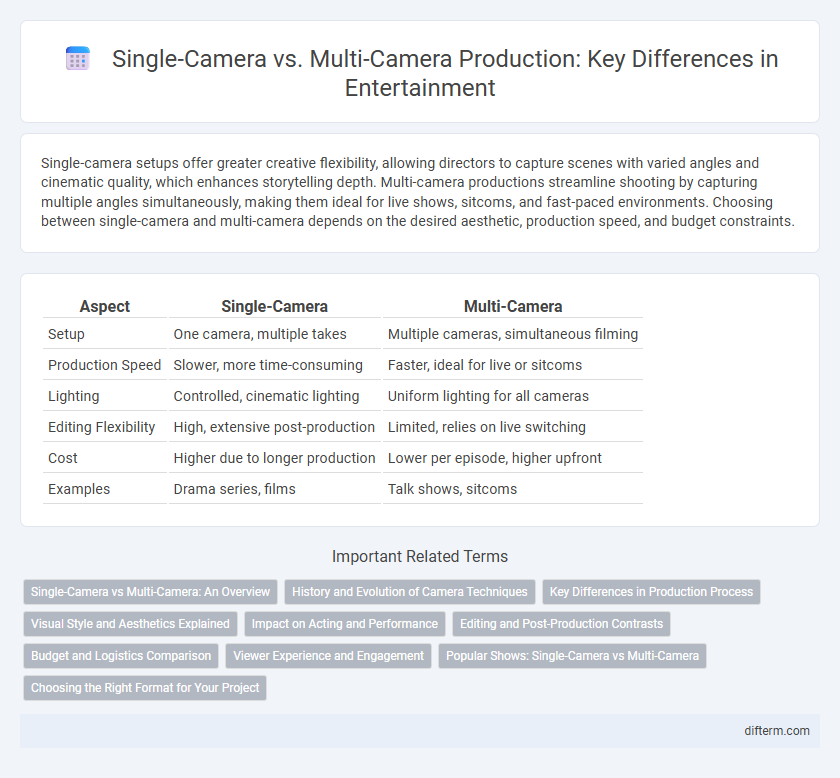Single-camera setups offer greater creative flexibility, allowing directors to capture scenes with varied angles and cinematic quality, which enhances storytelling depth. Multi-camera productions streamline shooting by capturing multiple angles simultaneously, making them ideal for live shows, sitcoms, and fast-paced environments. Choosing between single-camera and multi-camera depends on the desired aesthetic, production speed, and budget constraints.
Table of Comparison
| Aspect | Single-Camera | Multi-Camera |
|---|---|---|
| Setup | One camera, multiple takes | Multiple cameras, simultaneous filming |
| Production Speed | Slower, more time-consuming | Faster, ideal for live or sitcoms |
| Lighting | Controlled, cinematic lighting | Uniform lighting for all cameras |
| Editing Flexibility | High, extensive post-production | Limited, relies on live switching |
| Cost | Higher due to longer production | Lower per episode, higher upfront |
| Examples | Drama series, films | Talk shows, sitcoms |
Single-Camera vs Multi-Camera: An Overview
Single-camera setups capture scenes from one camera angle at a time, allowing for greater creative control, cinematic quality, and varied shot compositions, commonly used in dramas and films. Multi-camera productions use multiple cameras simultaneously to film scenes from different angles, streamlining editing and ideal for live or sitcom environments where real-time shooting is essential. The choice between single-camera and multi-camera significantly impacts production style, shooting schedules, and viewer experience in entertainment projects.
History and Evolution of Camera Techniques
Single-camera setups originated in early film production, allowing directors to focus on cinematic composition and lighting, creating a more controlled and artistic visual style. The multi-camera technique evolved primarily in television sitcoms during the 1950s, enhancing efficiency by capturing multiple angles simultaneously for live audiences. Over time, technological advancements have blurred the lines between these methods, adapting to diverse entertainment formats while preserving their historical roots.
Key Differences in Production Process
Single-camera production involves shooting scenes one at a time with a single camera, offering greater control over composition and lighting, resulting in cinematic quality. Multi-camera setups use multiple cameras recording simultaneously from different angles, enabling faster shooting and real-time scene coverage, ideal for live audiences or sitcoms. The production process for single-camera is more time-consuming with extensive editing, while multi-camera production emphasizes efficiency and continuity for live or taped performances.
Visual Style and Aesthetics Explained
Single-camera setups offer greater flexibility in framing and lighting, allowing for more cinematic visuals and nuanced aesthetic choices. Multi-camera productions prioritize efficiency with simultaneous angles but often result in flatter, stage-like aesthetics due to uniform lighting. The visual style in single-camera formats supports artistic storytelling, while multi-camera approaches cater to dynamic live performances and sitcom rhythms.
Impact on Acting and Performance
Single-camera setups in entertainment enable nuanced acting by allowing actors to perform scenes multiple times from various angles, fostering subtle emotional expressions and precise timing. Multi-camera productions capture performances live from several perspectives simultaneously, which often encourages broader acting styles and heightened energy to engage studio audiences. The choice between single-camera and multi-camera formats significantly influences actors' delivery, with single-camera favoring detailed performances and multi-camera emphasizing consistency and interaction.
Editing and Post-Production Contrasts
Single-camera setups allow for greater control over shot composition, lighting, and continuity, resulting in more polished and cinematic editing in post-production. Multi-camera productions capture multiple angles simultaneously, streamlining the editing process but often limiting creative flexibility and requiring less intensive color grading and visual effects work. The single-camera approach demands intricate post-production timelines, while multi-camera editing prioritizes efficiency and real-time switching to maintain live or live-to-tape workflows.
Budget and Logistics Comparison
Single-camera productions typically incur higher budgets due to extended shooting schedules and elaborate setups, demanding more time for lighting and scene composition. Multi-camera setups optimize logistics by capturing multiple angles simultaneously, reducing shooting time and labor costs, which makes them more cost-effective for live or fast-paced shows. Budget constraints often drive the choice toward multi-camera techniques in sitcoms and talk shows, while single-camera is preferred for cinematic quality despite higher expenses.
Viewer Experience and Engagement
Single-camera setups create a cinematic feel by offering varied angles and creative compositions, enhancing viewer immersion and emotional connection with the story. Multi-camera productions capture simultaneous perspectives, fostering a dynamic and continuous viewing rhythm that maintains audience attention and engagement. The choice between single-camera and multi-camera formats significantly influences pacing, visual style, and the overall viewer experience in entertainment content.
Popular Shows: Single-Camera vs Multi-Camera
Popular single-camera shows like "The Office" and "Modern Family" employ cinematic techniques, offering dynamic angles and a more naturalistic feel that enhances storytelling depth. Multi-camera classics such as "Friends" and "The Big Bang Theory" utilize simultaneous shooting in front of live audiences, creating lively atmospheres with quick scene transitions. The single-camera format suits narrative complexity and nuanced performances, while multi-camera productions excel in comedic timing and audience interaction.
Choosing the Right Format for Your Project
Single-camera setups offer cinematic quality and creative flexibility, ideal for dramatic storytelling and projects requiring diverse locations and angles. Multi-camera formats enhance efficiency by capturing multiple perspectives simultaneously, making them perfect for live events, sitcoms, and talk shows with fast-paced production schedules. Evaluating your project's narrative style, budget, and shooting environment is essential to selecting the appropriate format that balances quality and resource management.
single-camera vs multi-camera Infographic

 difterm.com
difterm.com